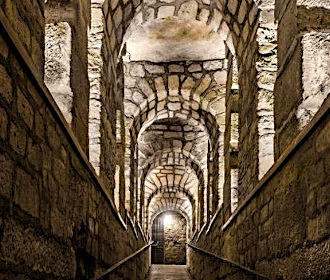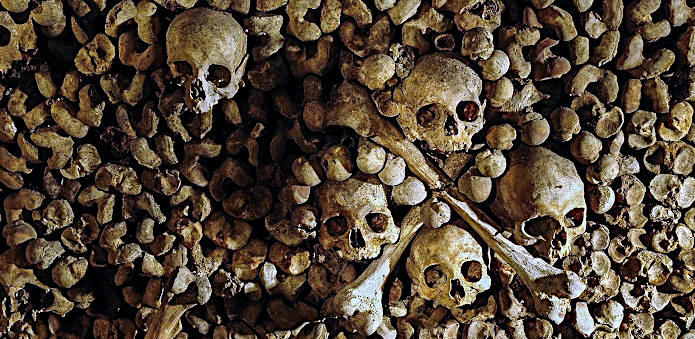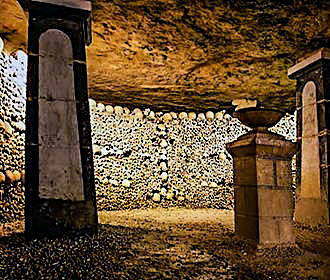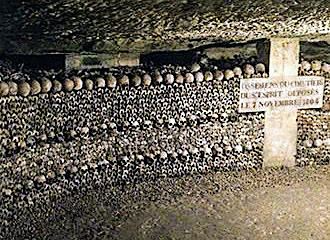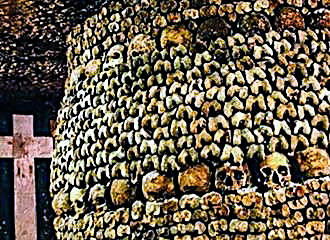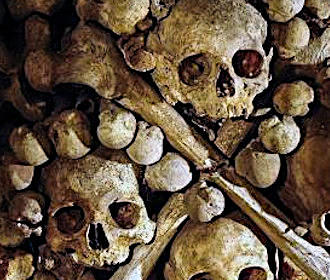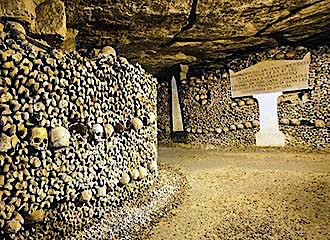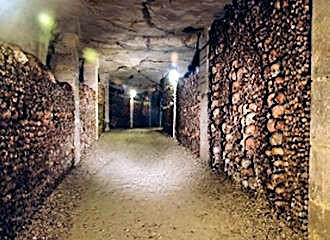The Catacombes de Paris at Place Denfert-Rochereau
The Catacombes de Paris is the famous mass burial place for millions of Parisians that were relocated to old limestone quarries underneath the city of Paris towards the end of the 18th century and have since become a place of intrigue plus one of the more unusual Paris tourist attractions.
About the Quarries
Now many of you will know that there are a lot of tunnels and quarries underneath the city of Paris, which have often caused problems for planning and construction, especially when a quarry could cave in causing damage to the buildings above.
So, in order to prevent this, in the year 1777 the Inspection Generale des Carrieres, or IGC for short, was established in order to monitor the stability of the quarries and also prohibit the digging of any new quarries, but there were some access tunnels dug as observation tunnels for better access and the monitoring of the underground network, which still continues to this day.
There is a very large network of underground tunnels and quarries all over the city of Paris, which span more than 300km. However entry to the tunnels and the Catacombes de Paris is restricted to a certain area for safety reasons and since 1955 it has been illegal to enter the catacombs de Paris unless permission is granted and you are accompanied by an official, but there is now one section open to the public.
Now this is where the quarries relate to the Catacombes de Paris
You see, for nearly ten centuries the cemetery close to the Saint-Eustace church in the Les Halles district had been used for burials, however it became the origin of major infections and disease for the inhabitants of the area, due to the number of improper burials and the amount of mass graves within this and many other churchyards in and around the area.
There were, as you would expect, multiple complaints made and eventually the Council of the State took action and announced the removal and evacuation of the cemetery on 9th November 1785 and it was decided that some of the old quarries would be utilised for this purpose.
It was decided that the bones should be moved at night and a blessing would be given, then a procession of priests would sing a burial service on route to their new destination in the Catacombes de Paris at Place Denfert-Rochereau.
The first bones were removed and placed within these old quarries on the 7 April 1786 and this ritual continued right up until 1788, but the Catacombes de Paris were utilised right through to 1814 to collect bones from many different cemeteries in Paris.
About the Catacombes de Paris Today
Today the Catacombes de Paris at Place Denfert-Rochereau have the remains of around six million Parisians that were transferred from cemeteries across the city to the transformed old limestone quarries and have been a curious fascination to people ever since.
Having been closed to the public for thirteen years, a section of the Catacombes de Paris is now back open where people can discover a labyrinth of obscure galleries and narrow tunnels with the bones laid out in a romantic-macabre type of decoration.
And this underground Paris museum allows you to see the different graffiti adorning the walls and pillars from the 18 century along with the sculptures of Port-Mahon in a gallery that were produced by a quarryman called Decure. In fact, he was a veteran of the army in the time of King Louis XV and was held captive within the Port-Mahon fortress and this model that he carved into the wall has now been fully restored and exposed with special lighting, so that visitors can experience even more about the history of Paris.
Access to Catacombes de Paris
Now as you can imagine, this is one of the unusual Paris museums and not really suitable or advised for young children and with this in mind, no child under the age of 14 can enter the Catacombes de Paris unless accompanied by an adult.
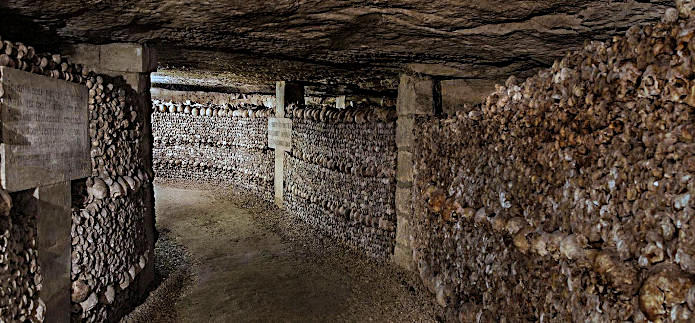
A visit to the Catacombes de Paris is also not recommended for any person suffering any cardiac problems, respiratory weakness or nervous disease plus it only has a temperature of around 14 degrees and is very humid.
It is also not accessible to the disabled or those with mobility problems as there are 131 steps going down and 112 steps going up in addition to the fact that the length of the walking visit is 2km.
There is also no cloakroom and therefore no large bags are permitted and any small bag must either be carried on you in front of you or held within your hand, plus no camera tripods are allowed. Additionally, there are only toilets at the exit.
The Catacombes de Paris visits are limited to a set number of people at a time for safety reasons, which does mean that at certain times of the year you may have to wait some substantial time before being allowed to enter and currently only online bookings made in advance are being accepted.
However, if you are interested in discovering this Paris museum of the Catacombes, then as of 2021 the cost of entry is €29, although there is a reduced rate of €27 for those in certain age groups and this price includes an audio guide, which is available in English, French German and Spanish.
Alternatively last minute tickets purchased and used on the same day are at cost of €14, but you would have to pay for the audio guide separately at a cost of €5.
The Catacombes de Paris at Place Denfert-Rochereau are open on a Tuesday to Sunday from 9:45am through to 8:30pm but the last admission is at least one hour prior to closing, plus they close on a Monday and on most National French holidays.
Located in the 14th Arrondissement of Paris, you will find the entrance located at 1 Avenue du Colonel Henri Rol-Tanguy at Place Denfert-Rochereau, which is by the Square de l'Abbe-Migne and opposite to the Musee du General Leclerc et Musee de la Liberation de Paris and the Musee Jean Moulin where you can discover more about World War II and the French Resistance.
Being at the Place Denfert-Rochereau, it is only a very short walk to the historical Gare Denfert-Rochereau train station that serves the RER B line, ideal for getting to Charles de Gaulle Airport.
This is also a station for the Paris Metro serving Metro line 4 and line 6, and just outside the train station you will see the stop for the OrlyBus, which is the dedicated shuttle bus for getting to Orly Airport.
Additionally, the Paris buses via bus lines 38, 59, 64, 68, 88 and 216 will all get you within very easy walking distance of the Catacombes de Paris along with the other Paris tourist attraction around the area such as the Lion of Belfort statue and the historical Barriere d'Enfer buildings that are classed as historical Paris monuments.
